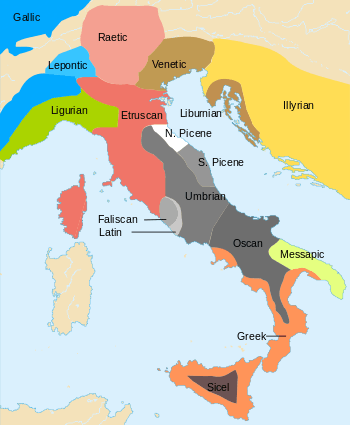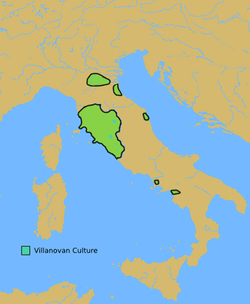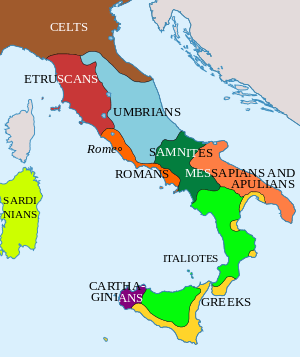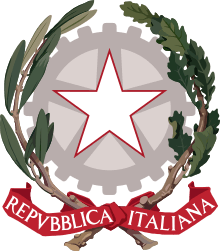Italic peoples
The Italic peoples were an Indo-European ethnolinguistic group identified by their use of Italic languages.
| Part of a series on |
| Indo-European topics |
|---|
 |
|
|
Philology
|
|
Origins |
|
Archaeology Pontic Steppe
Caucasus East Asia Eastern Europe Northern Europe Pontic Steppe Northern/Eastern Steppe Europe
South Asia Steppe Europe Caucasus India |
|
Peoples and societies Indo-Aryans Iranians
East Asia Europe East Asia Europe
Indo-Aryan Iranian
|
|
Religion and mythology
Indo-Aryan Iranian Others Europe
|
|
The Italic peoples descended from Indo-Europeans who migrated into Italy in the second millennium BC. Latins achieved a dominant position among these tribes, establishing ancient Roman civilization. During this development, other Italic tribes adopted Latin language and culture in a process known as Romanization. This process was eventually extended to much of Europe. The ethnic groups which emerged as a result are known as Romance peoples.
Classification

The Italics were an ethnolinguistic group who are identified by their use of the Italic languages, which form one of the branches of Indo-European languages.
Outside of the specialised linguistic literature, the term is also used to describe all of the ancient peoples of Italy including pre-Roman peoples like the Etruscans and the Raetians, who did not speak Indo-European languages.[1] Such use is improper in linguistics, but common in ancient and modern historiography.[2]
History
Copper Age
During the Copper Age, at the same time that metalworking appeared, Indo-European people are believed to have migrated to Italy in several waves.[3] Associated with this migration are the Rinaldone culture and Remedello culture in Northern Italy, and the Gaudo culture of Southern Italy. These cultures were led by a warrior-aristocracy and are considered intrusive.[3] Their Indo-European character is suggested by the presence of weapons in burials, the appearance of the horse in Italy at this time and material similarities with cultures of Central Europe.[3]
Early and Middle Bronze Age
%2C_The_Horse%2C_The_Wheel_and_Language.jpg)
According to David W. Anthony, between 3100–3000 BCE, a massive migration of Indo-Europeans from the Yamnaya culture took place into the Danube Valley. Thousands of kurgans are attributed to this event. These migrations probably split off Pre-Italic, Pre-Celtic and Pre-Germanic from Proto-Indo-European.[4] By this time the Anatolian peoples and the Tocharians had already split off from other Indo-Europeans.[5] Hydronymy shows that the Proto-Germanic homeland was in Central Germany, which would be very close to the homeland of Italic and Celtic languages as well.[6] The origin of a hypothetical ancestral "Italo-Celtic" people is to be found in today's eastern Hungary, settled around 3100 BCE by the Yamnaya culture. This hypothesis is to some extent supported by the observation that Italic shares a large number of isoglosses and lexical terms with Celtic and Germanic, some of which are more likely to be attributed to the Bronze Age.[3] In particular, using Bayesian phylogenetic methods, Russell Gray and Quentin Atkinson argued that Proto-Italic speakers separated from Proto-Germanics 5500 years before present, i.e. roughly at the start of the Bronze Age.[7] This is further confirmed by the fact that the Germanic language family shares more vocabulary with the Italic family than with the Celtic language family.[8]
From the late third to the early second millennium BCE, tribes coming both from the north and from Franco-Iberia brought the Beaker culture[9] and the use of bronze smithing, to the Po Valley, to Tuscany and to the coasts of Sardinia and Sicily. The Beakers could have been the link which brought the Yamnaya dialects from Hungary to Austria and Bavaria. These dialects might then have developed into Proto-Celtic.[10] The arrival of Indo-Europeans into Italy is in some sources ascribed to the Beakers.[1] A migration across the Alps from East-Central Europe by Italic tribes is thought to have occurred around 1800 BCE.[11][12]
In the mid-second millennium BCE, the Terramare culture developed in the Po Valley.[13] The Terramare culture takes its name from the black earth (terra marna) residue of settlement mounds, which have long served the fertilizing needs of local farmers. These people were still hunters, but had domesticated animals; they were fairly skillful metallurgists, casting bronze in moulds of stone and clay, and they were also agriculturists, cultivating beans, the vine, wheat and flax. The Latino-Faliscan people have been associated with this culture, especially by the archaeologist Luigi Pigorini.[3]
Late Bronze Age

The Urnfield culture might have brought proto-Italic people from among the "Italo-Celtic" tribes who remained in Hungary into Italy.[10] These tribes are thought to have penetrated Italy from the east during the late second millennium BC through the Proto-Villanovan culture.[10] They later crossed the Apennine Mountains and settled central Italy, including Latium. Before 1000 BCE several Italic tribes had probably entered Italy. These divided into various groups and gradually came to occupy central Italy and southern Italy.[12] This period was characterized by widespread upheaval in the Mediterranean, including the emergence of the Sea Peoples and the Late Bronze Age collapse.[14]
The Proto-Villanovan culture dominated the peninsula and replaced the preceding Apennine culture. The Proto-Villanovans practiced cremation and buried the ashes of their dead in pottery urns of a distinctive double-cone shape. Generally speaking, Proto-Villanovan settlements have been found in almost the whole Italian peninsula from Veneto to eastern Sicily, although they were most numerous in the northern-central part of Italy. The most important settlements excavated are those of Frattesina in Veneto region, Bismantova in Emilia-Romagna and near the Monti della Tolfa, north of Rome. The Latino-Faliscans, the Veneti, and possibly the Osco-Umbrians too, have been associated with this culture.
In the 13th century BCE, Proto-Celts (probably the ancestors of the Lepontii people), coming from the area of modern-day Switzerland, eastern France and south-western Germany (RSFO Urnfield group), entered Northern Italy (Lombardy and eastern Piedmont), starting the Canegrate culture, who not long time after, merging with the indigenous Ligurians, produced the mixed Golasecca culture.
Iron Age

In the early Iron Age, the relatively homogeneous Proto-Villanovan culture (1200-900 BCE), closely associated with the Celtic Halstatt culture of Alpine Austria, characterised by the introduction of iron-working and the practice of cremation coupled with the burial of ashes in distinctive pottery, shows a process of fragmentation and regionalisation. In Tuscany and in part of Emilia-Romagna, Latium and Campania, the Proto-Villanovan culture was followed by the Villanovan culture. The earliest remains of Villanovan culture date back to circa 900 BCE.
In the region south of the Tiber (Latium Vetus), the Latial culture of the Latins emerged, while in the north-east of the peninsula the Este culture of the Veneti appeared. Roughly in the same period, from their core area in central Italy (modern-day Umbria and Sabina region), the Osco-Umbrians began to emigrate in various waves, through the process of Ver sacrum, the ritualized extension of colonies, in southern Latium, Molise and the whole southern half of the peninsula, replacing the previous tribes, such as the Opici and the Oenotrians. This corresponds with the emergence of the Terni culture, which had strong similarities with the Celtic cultures of Hallstatt and La Tène.[15] The Umbrian necropolis of Terni, which dates back to the 10th century BCE, was identical in every aspect to the Celtic necropolis of the Golasecca culture.[16]
Antiquity
By the mid-first millennium BCE, the Latins of Rome were growing in power and influence. This led to the establishment of ancient Roman civilization. In order to combat the non-Italic Etruscans, several Italic tribes united in the Latin League. After the Latins had liberated themselves from Etruscan rule they acquired a dominant position among the Italic tribes. Frequent conflict between various Italic tribes followed. The best documented of these are the wars between the Latins and the Samnites.[1]
The Latins eventually succeeded in unifying the Italic elements in the country. Many non-Latin Italic tribes adopted Latin culture and acquired Roman citizenship. During this time Italic colonies were established throughout the country, and non-Italic elements eventually adopted the Latin language and culture in a process known as Romanization.[12] In the early first century BCE, several Italic tribes, in particular the Marsi and the Samnites, rebelled against Roman rule. This conflict is called the Social War. After Roman victory was secured, all peoples in Italy, except for the Celts of the Po Valley, were granted Roman citizenship.[1]
In the subsequent centuries, Italic tribes adopted Latin language and culture in a process known as Romanization. This process was eventually extended to much of Europe. The ethnic groups which emerged as a result are known as Romance peoples.
Genetics
A genetic study published in Science in November 2019 examined the remains of six Latin males buried near Rome between 900 BC and 200 BC. They carried the paternal haplogroups R-M269, T-L208, R-311, R-PF7589 and R-P312 (two samples), and the maternal haplogroups H1aj1a, T2c1f, H2a, U4a1a, H11a and H10. A female from the preceding Proto-Villanovan culture carried the maternal haplogroups U5a2b.[17] These examined individuals were distinguished from preceding populations of Italy by the presence of ca. 30-40% steppe ancestry.[18] Genetic differences between the examined Latins and the Etruscans were found to be insignificant.[19] Examined individuals from Rome during the time of the Roman Empire bore little genetic resemblance to the Latins, and were instead shifted towards Near Eastern populations.[20] During late antiquity, Rome's population was drastically reduced as a result of political instability, epidemics and economic changes. Repeated invasions of barbarians brought European ancestry back into Rome, resulting in the loss of genetic link to the Eastern Mediterranean and Middle East. By the Middle Ages, the people of Rome again genetically resembled European populations.[21]
See also
References
- Waldman & Mason 2006, pp. 452–459
- https://www.britannica.com/topic/ancient-Italic-people
- Mallory 1997, pp. 314–319
- Anthony 2007, p. 305
- Anthony 2007, p. 344
- Hans, Wagner. "Anatolien war nicht Ur-Heimat der indogermanischen Stämme". eurasischesmagazin. Retrieved 20 July 2016.
- "Language evolution and human history: what a difference a date makes, Russell D. Gray, Quentin D. Atkinson and Simon J. Greenhill (2011)".
- "A Grammar of Proto-Germanic, Winfred P. Lehmann Jonathan Slocum" (PDF).
- p. 144, Richard Bradley The prehistory of Britain and Ireland, Cambridge University Press, 2007, ISBN 0-521-84811-3
- Anthony 2007, p. 367
- "Italic languages: Origins of the Italic languages". Encyclopædia Britannica Online. Retrieved July 10, 2018.
- "History of Europe: Romans". Encyclopædia Britannica Online. Retrieved July 10, 2018.
- Pearce, Mark (December 1, 1998). "New research on the terramare of northern Italy". Antiquity.
- Waldman & Mason 2006, pp. 620–658
- Leonelli, Valentina. La necropoli delle Acciaierie di Terni: contributi per una edizione critica (Cestres ed.). p. 33.
- Farinacci, Manlio. Carsulae svelata e Terni sotterranea. Associazione Culturale UMRU - Terni.
- Antonio et al. 2019, Table 2 Sample Information, Rows 29-32, 36-37.
- Antonio et al. 2019, p. 2.
- Antonio et al. 2019, p. 3.
- Antonio 2019, p. 4. "[C]ompared to Iron Age individuals, the Imperial population shares more alleles with early Bronze Age Jordanians... Notably, only 2 out of 48 Imperial-era individuals fall in the European cluster (C7) to which 8 out of 11 Iron Age individuals belong... [F]ew Imperial individuals (n = 2) have strong genetic affinities to western Mediterranean populations."
- Wade 2019, p. 673. "People from the city’s earliest eras and from after the Western empire’s decline in the fourth century C.E. genetically resembled other Western Europeans. But during the imperial period most sampled residents had Eastern Mediterranean or Middle Eastern ancestry... The study suggests the vast majority of immigrants to Rome came from the East. Of 48 individuals sampled from this period, only two showed strong genetic ties to Europe... Invading barbarians brought in more European ancestry. Rome gradually lost its strong genetic link to the Eastern Mediterranean and Middle East. By medieval times, city residents again genetically resembled European populations."
Bibliography
- Anthony, David (2007). The Horse, the Wheel, and Language: How Bronze-Age Riders from the Eurasian Steppes Shaped the Modern World. Princeton University Press. ISBN 978-0-691-05887-0.CS1 maint: ref=harv (link)
- Antonio, Margaret L.; et al. (November 8, 2019). "Ancient Rome: A genetic crossroads of Europe and the Mediterranean". Science. American Association for the Advancement of Science. 366 (6466): 708–714. doi:10.1126/science.aay6826.
- Cole, Jeffrey (2011). Ethnic Groups of Europe: An Encyclopedia. ABC-CLIO. ISBN 978-1598843026.CS1 maint: ref=harv (link)
- Devoto, Giacomo; Buti, Gianna G. (1974). Preistoria e storia delle regioni d'Italia. Florence: Sansoni.
- Devoto, Giacomo (1951). Gli antichi Italici. Florence: Vallechi.
- GP (2001). MultiCultural Review: Dedicated to a Better Understanding of Ethnic, Racial, and Religious Diversity, Volume 10. GP Subscription Publications. ISBN 0823997006.CS1 maint: ref=harv (link)
- Mallory, J. P. (1997). Encyclopedia of Indo-European Culture. Douglas Q. Adams. ISBN 1884964982. Retrieved 23 March 2013.CS1 maint: ref=harv (link)
- Minahan, James (2000). One Europe, Many Nations: A Historical Dictionary of European National Groups. Greenwood Publishing Group. ISBN 0313309841.CS1 maint: ref=harv (link)
- Moscati, Sabatino (1998). Così nacque l'Italia: profili di popoli riscoperti. Turin: Società Editrice Internazionale.
- Pigorini, Luigi (1910). Gli abitanti primitivi dell'Italia. Rome: Bertero.
- Pop, Ioan-Aurel (1996). Romanians and Hungarians from the 9th to the 14th century. Romanian Cultural Foundation. ISBN 0880334401.CS1 maint: ref=harv (link)
- Pop, Ioan-Aurel (1999). Romanians and Romania: A Brief History. East European Monographs. ISBN 9735770377.CS1 maint: ref=harv (link)
- Treptow, Kurt W. (1996). A History of Romania. East European Monographs. ISBN 0880333456.CS1 maint: ref=harv (link)
- Villar, Francisco (1997). Gli Indoeuropei e le origini dell'Europa. Bologna: Il Mulino. ISBN 88-15-05708-0.
- Waldman, Carl; Mason, Catherine (2006). Encyclopedia of European Peoples. Infobase Publishing. ISBN 1438129181.CS1 maint: ref=harv (link)
Further reading
- M. Aberson, R. Wachter, «Ombriens, Sabins, Picéniens, peuples sabelliques des Abruzzes : une enquête historique, épigraphique et linguistique », in : Entre archéologie et Histoire : dialogues sur divers peuples de l’Italie préromaine, Bern, etc., 2014, p. 167-201.
